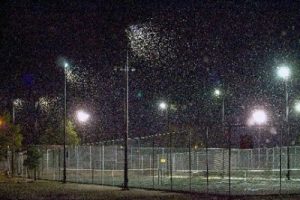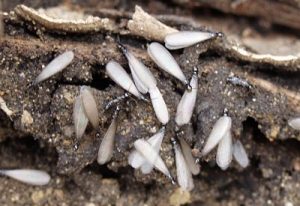The termites are a nightmare for all the house owners in US.
In the worst case, the infestation by for example, Formosan subterranean termites can bring the whole structure to the brink of an irreversible damage in just three-month time.
Even if the intruders are only a small colony of drywood local species, it still might force you to lose your favorite pieces of furniture.
Altogether the cost of the termite damage control and treatment reaches over $1billion in US each year.
Hide content
- What is a swarm and what to do with it?
- What do swarming termites look like?
- Photo
- What to do if you found swarmers or their wings in your house?
- Different termites – different methods
- How to prevent the winged termites from entering the house?
- Useful articles
- Helpful video
The main problem with the termites is that it is a small insect, nesting in the walls (in case of the drywood species) or in the soil under your house (subterranean termites).
Until the substantial damage is done you might not even notice that the silent destruction has already started.
The easiest way to recognize that you have a termite problem is to notice a swarm or just find some flying termites in your house.Even if the only thing you’ve found are the shed wings – they can help you realize if you have termites or ants in your household and if it’s the first – what kind of termites are they. Because the treatment these pests need is absolutely different.
Learn more about drywood termites: signs of their activity; best methods of treatment: spot treatment and DIY methods; how to get rid of them in furniture?
What is a swarm and what to do with it?
The swarm is formed by thousands of flying insects emerging from the nests.
This are the reproductives of either termites or ants.
Most of the time swarms occur in spring time, or on a dump summer morning.
All the winged individuals depart almost simultaneously.
If the swarm started right inside your house – there’s no doubt that you have drywood termite problem. Pay attention where it emerges from and inspect the area for some hollow wood.
If you found it, then there’s your colony. If the winged insects are emerging from underground, it could be both ants and subterranean termites.
In the early morning when the lights outside are still weak the swarmers may get interested in the electric light from your windows. This is why you might find some shed wings on your door or window sills after the swarm.
The main purpose of the swarm is to spread the reproductives around and colonies new places. So the winged termites will not harm the household themselves, but their offspring most certainly will.For the winged termites inside your house you can simply use the bug spray, though if those are subterranean species they will die without access to the soil really quickly.
But the fact that alates (winged termites) bring no harm themselves doesn’t mean you should ignore their presence. The thing is, once you found at least the wings shed inside your house it might have two possible causes:
- You already have termite infestation.
- There’s a danger of infestation.
What do swarming termites look like?
Now, let’s move to the most important questions: “What do flying termites look like?”, “What does a termite look like with wings?”, “What do winged termites look like?”, “What does a winged termite look like?”, “What color are termites wings?” etc. The answers on this question will be done in this section, so keep reading carefully.
If you see some kind of small winged creature in your house – don’t panic straight away. It’s quite easy to tell the termites from other insects.
Normally the only one you can mistake the winged termite for is the winged ant. But if you look closely there’s a lot of differences between the two:
- wings;
- body shape;
- antennae.
It may seem from far away that the ant and termite are very similar, but this is not true at all.
Normally you don’t need any special magnifying equipment to see the differences.
Interesting! Ants and termites have very similar behavior, colony structure and habits, but actually biologically they are not related as the termites are believed to be the descendants of the wood-eating Jurassic cockroaches.
Both the ants and termites have two pairs of wings. But while the termite has all four similar in size and shape, the ants have the front pair consistently larger than the once at the back.Also the length of the wings vs the body length will be different. The wings of the termite reproductive are almost twice longer than the body, the ant wings are more proportional.
The body shape of the ant is very distinctive, they have a head, an abdomen, and a thorax, separated by the thin waists. The same body have the flying ants, which is not the case for the termites which have only the head and the rest of the body is same width all along.
And the last thing – the antennas of the flying termite are straight. All the ants have them elbowed.
So, as you see it’s hard to mistake one for another once you’ve had a good look. The similarities are only that they both have six legs and they can be similar in color- from dark brown to pale yellow.
Learn more about subterranean termites: signs of their activity; best methods of treatment and DIY methods. Eastern subterranean termites and their tunnels and tubes with photo.
Photo
Photos of termites with wings:
What to do if you found swarmers or their wings in your house?
Let’s say you found some alive winged termites or just the shed wings in your house and you’re sure those are not ants, what’s next?
Well, our strong recommendation would be to contact your local pest control operator and ask them for the inspection.
The best results can be achieved if you keep the evidence you’ve found untouched.
The specialist can sometimes get a lot of information from the place of the wings was found or tell the age and size of the colony by the size of the alates.
If you absolutely need to clean the place – make sure you collected some evidence in clear zip bags. You do not want to make mistakes with winged termite identification infesting your property and choose a wrong treatment.Different termites – different methods
Why is it so important to identify the pest first and not to order the particular treatment straight away? The thing is the subterranean and drywood species have absolutely different nesting habits.
The drywood termite can form the colony inside the timber structure of the building and the entire nest can be located in one piece of wood. So the fumigation methods for example, will be very efficient. Or in certain cases, it’s enough to simply burn the infested wooden plank.
This wouldn’t work with the subterranean species. Fumigation would kill the pests inside the house, but wouldn’t stop the termites from reentering, as their actual nest is in fact situated underground. In this case the barrier or bait methods would do the trick.
Here you can learn more information about effective treatment method called tenting (fumigation): dangers for termites, preparing for fumigation and cleaning after, how long does this procedure last?
How to prevent the winged termites from entering the house?
Wrong question. The alates are not the direct threat to your property. Basically the ones you need to protect your house from are the workers, which are the primary wood-eaters in the colony.
The winged termites can help you to recognize the infestation, but what you really need to fight is the colony itself and prevent the infestation altogether.
Once you decided to do the construction work for a new structure on your soil you have to think about prevention methods.
The barrier soil treatment methods will stop the subterranean termites infesting your building and preparation of the wood with the special oils or chemicals will prevent the drywood termites to thrive on your timber as well.
If you’re not building from scratch, then start with a proper inspection of your new house to determine if there is an existing problem already.
The best way is to use the professional help.
But if you’d like to do it yourself, check for these signs:
- frass;
- shed wings or dead alates;
- hollow wood;
- mud tubes.
Whenever you find any of these signs, begin the extermination procedures as soon as possible. Nothing good will come from waiting. Once again, our best recommendation is to leave it to the pest control operators.
Find a good company and make a contract with them, so they don’t only treat your household against termites once, but support it by making regular checkups.
These guys have the experience in determining the infestation, the skill that you don’t want to learn the hard way.
Useful articles
If you interested in more information of termites we recommend you to read the following articles:
- All types of termites. Are they harmful to humans? Can they bite you? And what is the difference between drywood and subterranean ones?
- What does swarmers of different species look like: drywood, subterranean, formosan?
- Signs of infestation outside and in the house: in walls or furniture.
- What does termite holes look like? What is droppings and is it toxic to humans? Do termites make noises?
- Posible termite damage, how does it look like? Examples of damage in walls and wood floors.
- All about flying termites: swarming season and what to do if there are swarmers in your house?
- How do they do nests and mounds? How to find it in your garden or inside the house?
- Termite life cycle – from egg to larvae. And social hierarchy: workers, soldiers, queen.
Helpful video
How big are flying termites? The answer on this question and other differences between flying ants and termites will be elucidated in the video below:
Hopefully you’ll never face the termite infestation, but always keep your eyes open and do not ignore the signs. If you find any infestation as it starts, it will be much easier to get rid of it.







